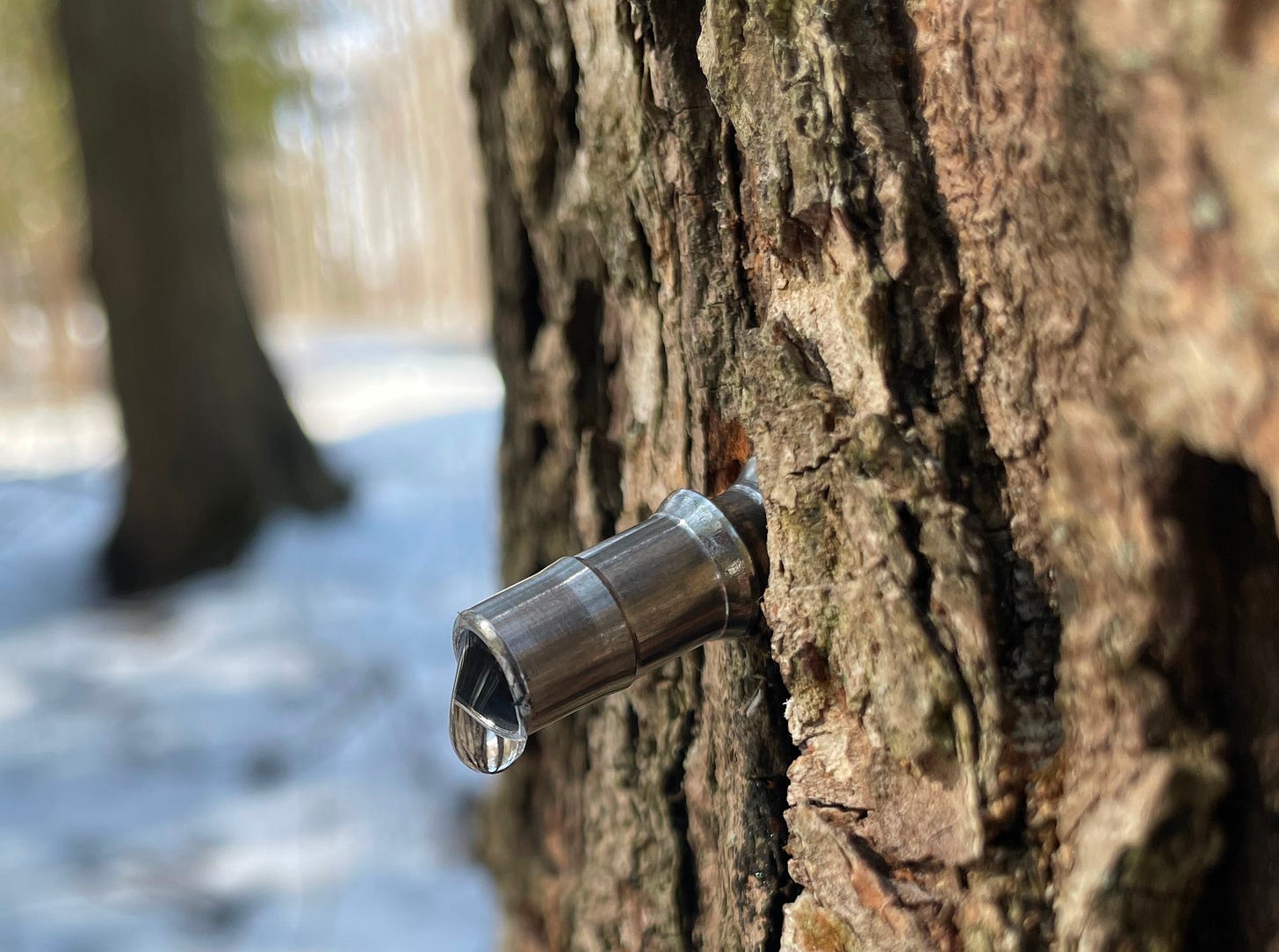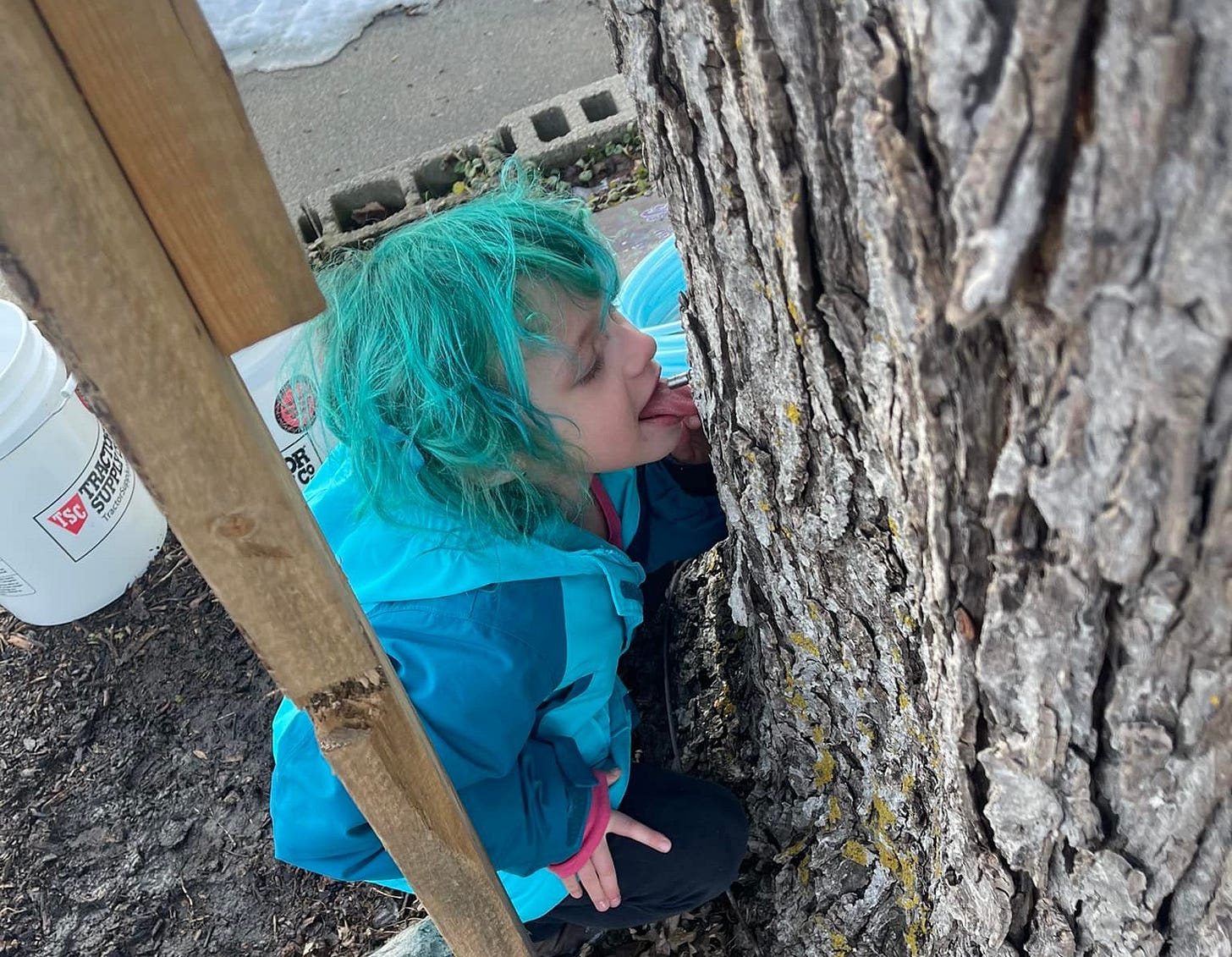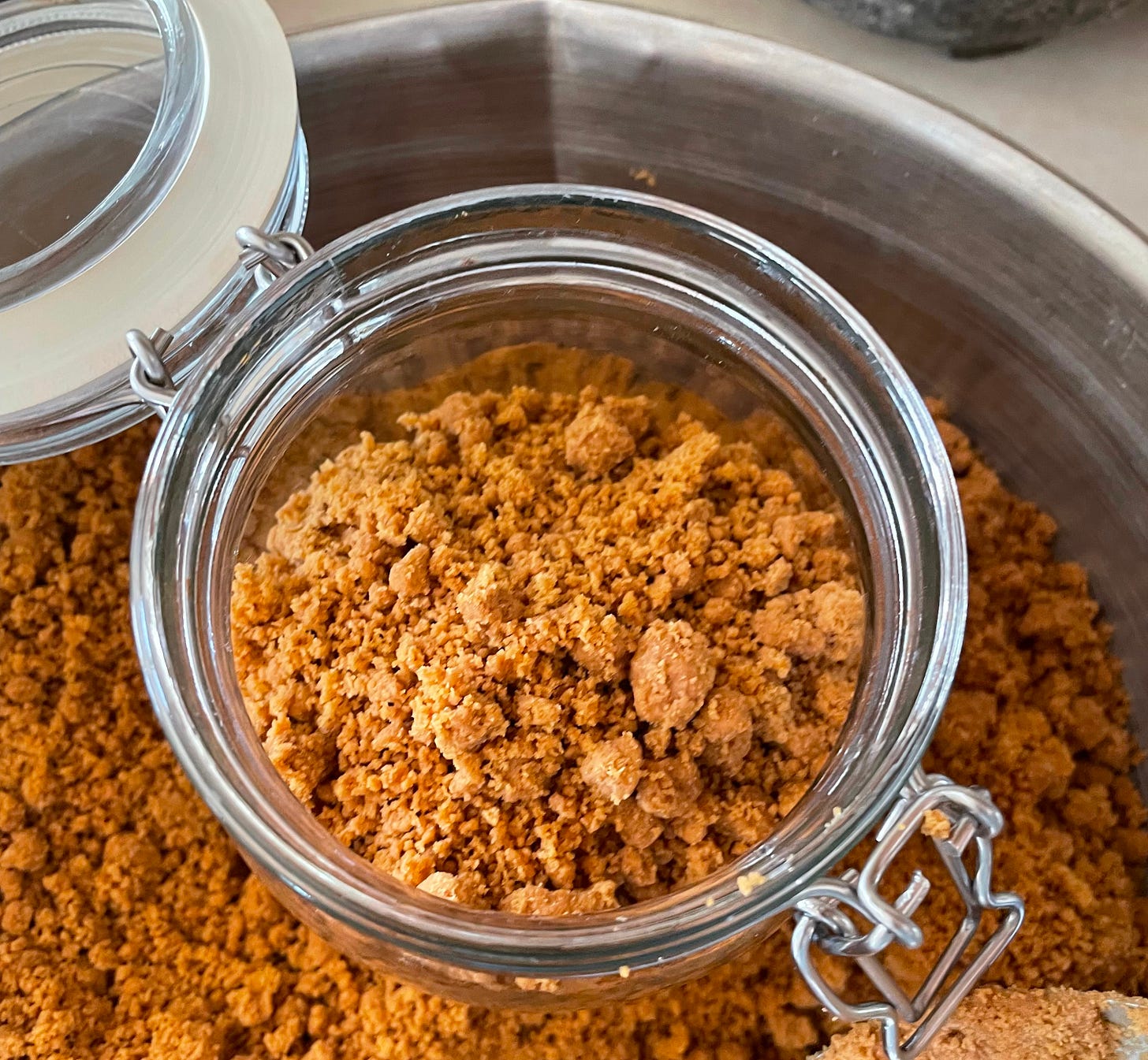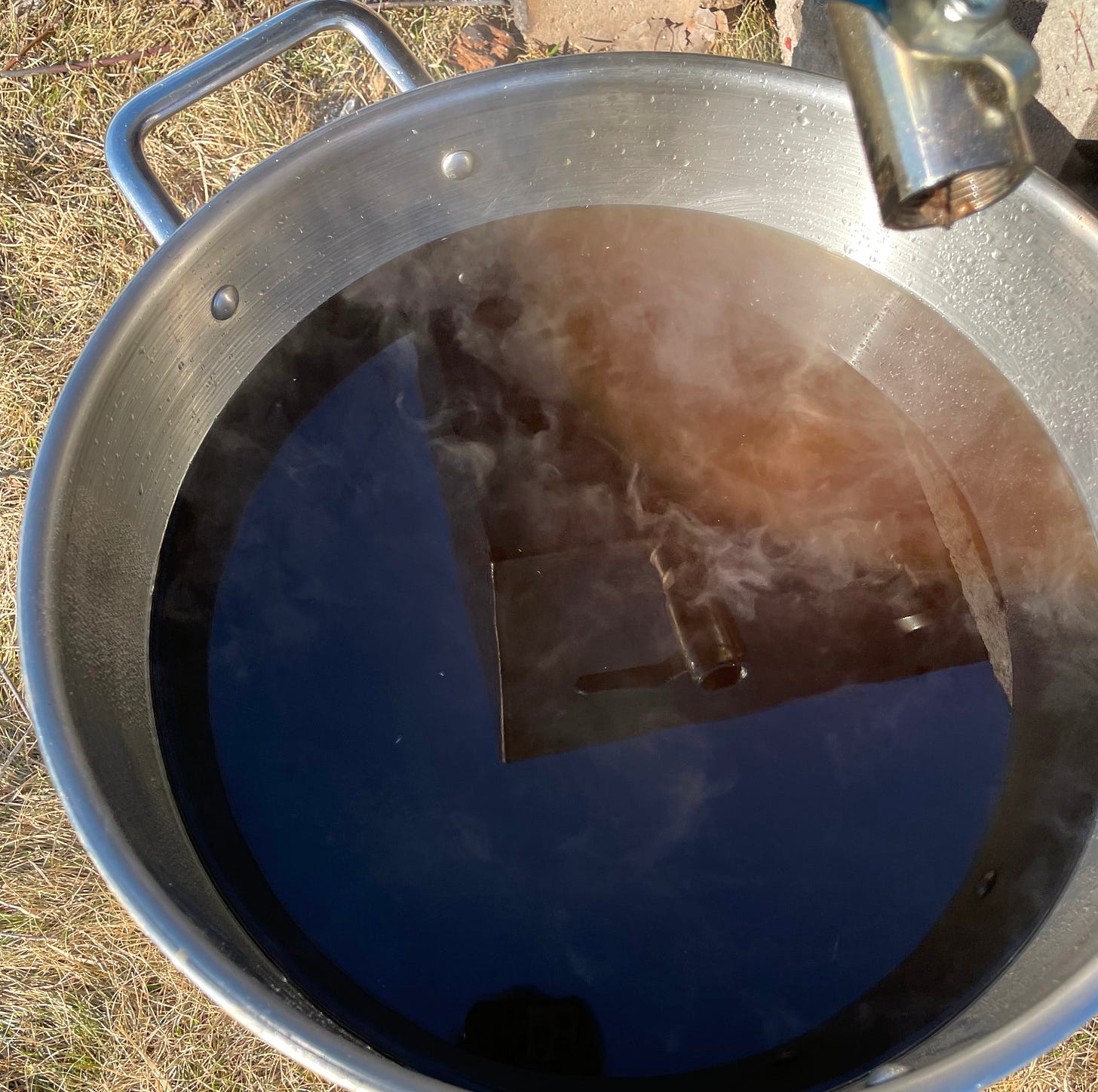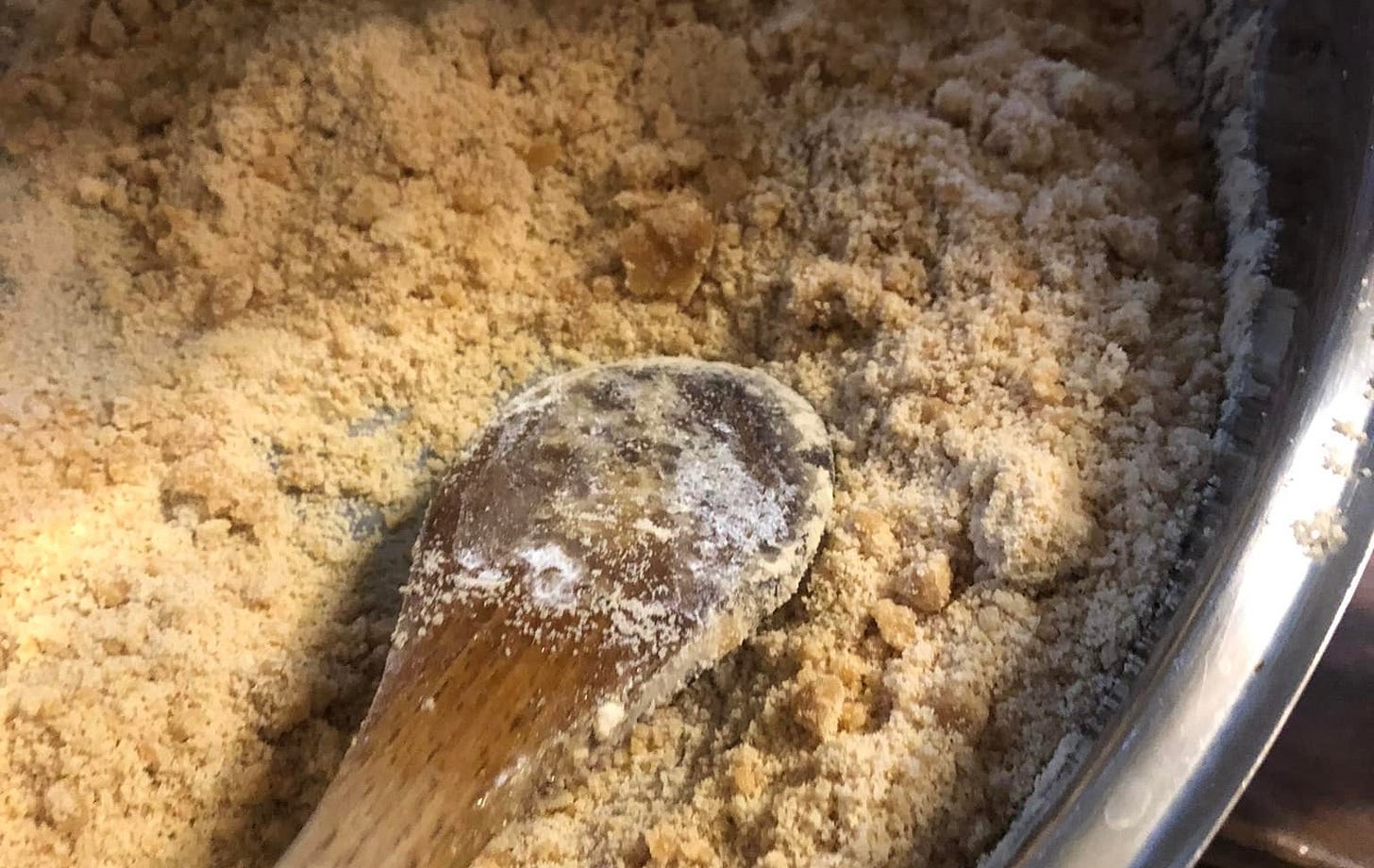Lessons From The Sugarbush
Breaking ice in frosty buckets scattered through the woods, or the front yards of my neighbors, on clear afternoons.
Catching the evening golden hour in late winter, when normally I’d be inside.
Long nights spent tending the fire, stars crisp overhead, the cold deep and clear, stark contrast against the glowing coals and rushing sparks of the fire and billowing clouds of steam off the pan.
Children, thrilled, catching drops of sweet sap on their tongues, eagerly awaiting the first taste of still-hot syrup drizzled over ice cream.
Greeting long-sleeping neighbors on warm days at the trees, coming together to taste the sweet sap dripping down trunks and into buckets. A fishing spider, buzzing honeybees, comma butterfly, sleepy flies. Finally, the trill of chorus frogs as we bring in the last boil of the year.
The almost-mystical alchemy of watching clear sweet water simmer into golden syrup, then molten sugared lava bubbling thickly in the pan, then slowly lightening again as you stir, stir, stir until it’s light, crumbly, crystalline sugar. A forest’s gifts, distilled, into crystalized sunlight, sweet and nourishing for the people.
Sugarbush magic
.
Syrup making wasn’t a skill I grew up with. We must have had some maples in our woods, but our area was predominantly oak-hickory, and we were busy enough without an extra spring hobby. I tapped trees for the first time in 2021, when we still lived in our little urban homestead in Lansing, MI. My father picked up one of those little online tapping kits, a friend snagged me empty soy sauce buckets (of all things) from the restaurant he managed, and I picked up a couple cheap hotel pans (the kind catering is served in to keep it warm). We didn’t have access to a single sugar maple that year. Instead we tapped the trees in our yard, and at my farm: a couple giant silver maples, a black walnut or two, and a few of the introduced Norway maples common as shade trees in our region. When the couple giant silvers surprised us with generous volumes of sweet sap, I became delighted to know that despite their reputation as sub-par sugaring trees, their scientific epithet was Acer saccharinum, a hint toward their potential for gifting sugar to us eager humans.
An Anishinaabe friend of mine told me that in his culture, silver maples were indeed known to give generous amounts of sap, albeit in short bursts (in contrast to the more even and restrained gifts of sugar maples which extend over a much longer period of time). As an overly-busy working mother of 4 kids (at that time between 2 & 5), I was content with a short fast season, and embraced the monster silver maples so common in our neighborhood. The next year we went up to around 20 taps, and made 6 or 7 gallons of syrup. We were so quickly hooked to the charms of sugaring!
Sugaring is a labor intensive process. It starts in late winter, as the frost begins to break and the daytime temps rise above freezing with more frequency. Sap flow is a product of pressure differentials caused by temperature fluctuations, managed by the trees to their advantage. The nutrients that were concentrated in roots below ground for the winter dormancy are brought back into the aboveground tissues to prepare for budbreak and flowering. It must cost the trees an incredible amount of energy to make flowers and leaves anew in the spring, yet they can and do share some of this sweet, purified energy with those animalia clever enough to access it. Humans, sapsuckers (a subset of woodpeckers), and squirrels will all pierce the trees to access their flowing sap. A wider variety of critters will eagerly feed on sap made accessible by the others–bats, hummingbirds, ants, aphids, porcupines, bees, mealybugs, and more.
Our more-than-human kin accept the sap as-is, consuming it as it flows freely from the tree. We can do this too–Fresh maple sap is a special, fleeting treat. Full of just enough sugar to be faintly sweet, as well as a myriad of electrolytes, phytochemicals, and antioxidants, sap could easily be considered “Nature’s Sports Drink.” It’s amazingly refreshing, and so good for us.
However, we humans have figured out that if we concentrate down the sugar, we can store this precious gift to use all year. Traditional sugaring practices, as developed by the Indigenous Peoples of the Northeast and Midwest, centered around sugar making, not syrup. This sugar would be stored in birch bark cones (birch bark holds many natural preservative qualities, and was used to store several dried and concentrated foods), to use as needed throughout the year.
Today we’re more accustomed to using maple in syrup form, drizzled over pancakes, used to marinade meats, or to flavor desserts. Our household uses maple syrup for all of the above, and one of us enjoys it in their morning coffee. My goal for this year, though, is sugar. After many years of working honey and maple into as many of our sugar applications as possible, I’ve resigned myself to the truth that these liquid sweeteners can never fully replace granulated sugar in baking. Maple, however, can be granulated sugar. We’ve never been able to produce enough to make more than a few pounds of sugar, but we’re hopeful that this year might be the year. With honey bought in bulk from local beekeepers replacing any sweetener we use in a liquid form (think canning fruit, making jams, and the like), and maple sugar in the more delicate baking applications, we just might be able to replace all our households sugar (at least when it comes to things made from scratch in-house. I’m not pretending we never buy store bought cookies or ice cream).
Why do we care? Sugar is cheap, after all. In part, it’s just a point of joy and pride for us whenever we can check off a new food group to be produced locally. As of now, essentially all our meat, eggs, vegetables, and fruits are. We still buy (most) grains, dairy, and some of our sugar commercially, though. Fats are a mix–we produce our own lard, but use store bought butter and olive oil when lard isn’t a good fit for the meal.
We can even buy relatively locally produced sugar. Michigan is a hub for sugar beet production. Our thumb region, not too far from where we live, is primarily sugar beet fields. The Michigan brand, Pioneer Sugar, is usually available at the local grocery store.
However, pretty much any commercially available sugar is a product of industrial monoculture farming systems that are absolutely destroying the ecosystems around them. Sugar cane plantations have a long history of exploitation and destruction. The sugar beet is grown under the same production styles as the ever-present corn, soy, and wheat rotations. They’re a genetically modified crop, round-up ready, and represent large amounts of chemical herbicide sprayed onto our land. When choosing between destruction in far-off lands and destruction here at home, I’ll choose home, knowing at least my money is supporting local families and industries. But I’d rather not support any of it.
…
Once trees are tapped, the work begins. Buckets must be monitored, and sap gathered. Modern, professional systems generally operate on forest-wide tubing systems that collect all the sap into centralized tanks through vacuum systems. The main work here is making sure clever rodents don’t chew through your lines after the sugary goodness flowing through them. We use an adaptation between this and the older hanging-bucket system. Metal spiles (the part that goes into the tree) are connected to five gallon food-grade buckets with short lengths of tubing, called drop lines. We are collecting sap from multiple sites–our beautiful homestead is mostly open land, we only have a handful of mature maples onsite. The five gallon buckets give us leeway, and reduce the number of times I need to drive to our various sugarbush sites. But, everything is reusable, and should last many years before it needs replacing.
Collecting sap is a lot of carrying heavy buckets around. I’ve been reflecting a lot this spring on my childhood, and the admiration I felt watching the men in my family carry a full five gallon bucket in each hand. The epitome of strength to my young eyes! Now I find myself doing the same, though perhaps with less ease.
We gather sap as needed throughout the week, and keep it cool in shady locations until we are ready to boil. In lighter parts of the season, we boil once a week. In peak season, when flow is rapid and generous, we may need to boil a couple times in a week.
We are hobbyists, and have a cobbled together blend of simple DIY setups with a few professional tools to aid in efficiency. The bulk of our boiling takes place outdoors over a wood fire on a simple cinder block “arch” (the term for the firebox that holds your pan). We upgraded from our little hotel pans to a proper 2’x4’ evaporator pan. This has room for us to grow into it, and allows us to boil down a lot more sap in the same amount of time.
This setup doesn’t give us a lot of control, however, especially at the relatively low volume of sap we are processing (our most recent boil was somewhere around 70 gallons of sap, probably the most we’ve done in one go so far, but still small). So, we remove our sap from the outdoor fire once it’s reduced enough to fit in our largest stockpot, and finish indoors on the kitchen stove where I can turn the heat off in an instant. From there we bottle and store. I generally process further into sugar later, though this year I may take some straight into sugar to reduce the inevitable losses that occur when transferring between pan to bottle to pan again.
I don’t think I could give a proper accounting of the labor involved in our sugar making process. A few half days spent tapping. Collecting from all three sites is probably a half day every time, altogether, and that ranges from a once a week need in the slower part of the season, to perhaps as much as every other day, or even more, for a week or two in the peak of the season, especially if we get a big rush in our silver maples as I have in some years. Each boil is a day of tending the fire and monitoring sap levels, followed by another couple hours of passively keeping an eye on the pot simmering on the stove. Professional setups can seriously increase the efficiency, but there is a reason why pure maple syrup is pricy! We will probably never sell syrup, or only in tiny token amounts to complement other products.
So why bother at all?
For us, there is no question in our minds that our annual sugaring tradition is worth doing.
The magic of this process: sweet sugar gifted freely from the trees, transformed into a heavenly product that is essentially joy distilled in a bottle, is worthwhile in and of itself. My husband and I both relish the time spent outside, doing real, tangible work, at a time of year where the temperature is just cold enough that we might not otherwise spend the day out-of-doors. For us, sugaring season has become the new herald of the spring rush. Before sugaring, that rush came when the ground was ready to work–usually sometime in March–and especially when the first plantings begin in early April. Traditionally in our area, sugaring would have been a March, perhaps early April activity. This year has proven a return to tradition, but in most of the years I’ve sugared, February has been the main month. As outdoor-enthusiast busy-bodies, we appreciate the earlier call to return outside.
The work is hard, but it is joyful. There is such satisfaction to be had in using our bodies and the resources at hand to produce something so obviously wonderful and worth having. In a modern context, that is a simple pleasure that can be hard to find.
Learning to become more in tune with turning of the seasons is another happy side effect of sugaring. For me, spring begins weeks earlier than it might otherwise. I see firsthand the earliest, otherwise invisible signs of the great spring awakening: the flow of sap from root to crown. We are outside to herald the return of our various bird neighbors: red winged black birds, robins, the geese in their loud and sometimes silly movements. We will pay rapt attention to the swelling of buds, and the opening of the too-often-ignored early spring flowers that can carry the awakening bees through their own hunger moon. These things mean the end of the sugaring season, as sap flow slows and the sap itself turns bitter and green tasting.
Of course, the biggest lessons learned in the sugar bush are gratitude, and acceptance. How can it be that these beautiful trees share so freely their sweet gifts? The woodland provides us with the sugar, and the fuel needed to concentrate and store it. What magic is this? It’s a profound reminder of the joy and abundance inherent in the natural world. A life in tune with nature isn’t “Nasty, brutish, and short,” it’s loving, rich, and bountiful. When we experience, firsthand, that something as precious and sweet and deeply nourishing as maple sugar can be obtained, freely, by anyone in possession of a little bit of know-how and a willingness to put in the time, it’s a profound reminder of the lie our society is built on: this fundamental lie of scarcity, this charade of laboring and oftentime pointless tasks, or sinister and destructive endeavors, to gain tokens to exchange for impoverished versions of the resources we need to live. What is processed and industrially farmed food to the richness and nourishment of whole, natural foods? What does sharing our lives through the screen of social media compare to time spent in the company of true community?
Acceptance, relinquishing control… This one is hard, and I am frequently in the ranks of worried hobby maple producers obsessing over the weather. Will we get a good run this week? Will this coming warm spell bring a fast bud break, and a short season? Will it get below freezing tonight? Should I tap trees now, in this first warm spell, or wait to make sure the weather really is breaking? It’s so easy to fall into obsession trying to predict a future we cannot influence, as we try to predict the outcomes of a process entirely outside of our control. Every year in the sugar bush is different. Sometimes the season is a fast 2-3 weeks long, a mad sprint as the trees give what they will in a quick rush and then are done. Other seasons are slow and steady, 6 weeks of stable temperatures and steady sap flow. You never know, and it's no use obsessing over the weather beyond planning the timing of your next boil or gauging how often you need to empty your buckets. Sugaring is a sublime lesson in relinquishment and acceptance. The weather will be its own fickle self, and the trees will do what they do. All you can do is be prepared and accept the gifts as they are given.
I suspect sugaring may be an ideal antidote to the pitfalls of modern society. And while sugaring could never make economic sense for us when measured in dollar value of goods produced compared to our labor, we are grateful to have found this most precious gift. Sugaring has brought me closer to the land and my fellow kin sharing this space with me. It has brought me stronger muscles, and clear, sleepy nights spent in the stark cold, tending a deep bed of glowing coals. Sugaring enlivens us in a way that modern daily life so infrequently does. It reminds us of the preciousness of the sugar worked so hard for, and of the generosity of plants. It helps us be generous in turn–what gift could be more precious than a glowing jar of rich syrup, lovingly tended over multiple days of labor? And how could we not be generous with something that was gifted to us in the first place?
Maple sugaring has many important roles in a resource and ecology wise society, but I suspect it’s biggest role may be in nurturing our souls.
Recipe Corner
Who doesn’t love pancakes topped with pure maple syrup?
Pancakes are a favorite breakfast in our household, and I usually make them at least a couple times a week. On a busy school morning, I need the convenience of pre-made pancake mix. I don’t, however, need my kids eating refined empty carbs, nor do I have the budget for overpriced “health food” mixes that might make a breakfast and a half per box. This 100% whole week DIY pancake mix is the solution! The secret: using white whole wheat flour. Most whole wheat flour is made from hard red wheat berries. Red wheat is higher in protein, which is ideal for bread making. Flour made from white wheat berries, however, produces a lighter and sifter product with all the same health benefits of whole grains. I have found that using white wheat flour in recipes results in a generally more palatable product when feeding picky kids (or partners). When made with fresh eggs and whole milk, the result is a nourishing whole grain meal. I often add a boost of micronutrients with a few tablespoons of mild greens powder, or fruit powders, into the mix. This is entirely optional, however!
This recipe can be adjusted for waffles by adding an extra 2-3 tablespoons of oil to the batter. They are a little more dense than traditional waffles, but my kids devour them!


